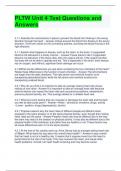PLTW Unit 4 Test Questions and
Answers
4.1.1 Describe the mechanisms in place to prevent the blood from flowing in the wrong
direction through the heart. - Answer-Valves prevent the blood from flowing in the wrong
direction. There are valves on the connecting arteries, and keep the blood moving in the
right direction.
4.1.1 Explain what happens to tissues, such as the heart, or the brain, if oxygenated
blood is not delivered in a timely manner. - Answer-Tissue starts to die if oxygenated
blood is not delivered. If the tissue dies, then the organs will fail. If the organs fail then
the body will not be able to operate and die. This is especially in the brain, brain tissues
rely on oxygen, and without, significant brain damage can occur.
4.1.2What are two differences you see when comparing the four chambers of the heart?
Relate these differences to the function of each chamber. - Answer-The left chambers
are larger than the right chambers. The right atrium and ventricle function is for
transporting deoxidized blood, while the left atrium and ventricle functions for
transporting oxidized blood.
4.2.1 Why do you think it is important to take an average resting heart rate versus
relying on one value - Answer-It is important to take an average heart rate because
external factors can impact the heart rate such as previous positions, temperature,
previous physical activity, etc. This average allows for a reliable heart rate.
4.2.1 What are some factors that can increase or decrease the heart rate and the beat
you feel at each pulse point? - Answer-• Raise - stimulants, emotions, drugs, activity
• Lower - position, drugs (depressants), alcohol
4.2.1 Propose reasons why the heart rates of different people are different when
exposed to the same stressor or to the same physical activity, even though their resting
heart rates are the same - Answer-People's heart rate may be different due to the way
the brain may react to the stressor or physical activity. It may also be different due to the
physical health of the individual, and rather they are healthy or not. These factors may
all cause differences even if it is the same stressor.
4.2.1 At the time of her cardiac work-up, Anna Garcia had an average resting heart rate
of 98bpm. What does this say about her overall heart health? - Answer-It says overall
that her heart is not at a healthy rate. It means that it requires more from the heart to
pump blood to the rest of her body. This may overwork the heart, and cause other
health problems. Overall, her heart health is lacking and may become worse.
, 4.2.2 Did you get the same blood pressure reading manually as you did with the use of
probes? Provide at least two reasons these values may be different. - Answer-a. No.
i. Firstly, the probe could be more accurate than the manual reading. This could be to
human error or just the fact of technology.
ii. Secondly, other factors in between measuring the two readings could affect the
reading. Temperature change, eating, position could all affect the readings.
4.2.2 What are two causes of blood pressure changes that might occur in a person
within a given day? - Answer-a. Eating. The flux of nutrients such as sodium, could
change the blood pressure. These changes may be minor, but the food we eat affects
our body and how it acts.
b. Position. Different positions require different requirements from your body, so if you
are lying down versus standing up, it might take more energy standing up. When you
are relaxed lying down, then blood pressure will be lower due to the relaxation.
4.2.2What did you need to keep constant in your experiments? Why was it important to
keep these factors constant? - Answer-The same person, the same amount of time
between readings and for the readings, the same number that is pumped to in the
beginning, and the same temperature. These factors must remain constant because if
not other factors that are not the independent variables could change the data, and the
data would be corrupted.
4.2.2Explain how an ACE inhibitor might have helped Anna mediate her blood pressure.
- Answer-It works by blocking the body from producing a chemical called angiotensin II.
Angiotensin II enters the blood stream, and makes your blood vessels become
narrower, which gives your blood less room to move (raises blood pressure). The ACE
inhibitor stops this chemical, and in turn relaxing the blood vessels and lowers blood
pressure.
4.1.1 Which chamber of the heart do you think is the most muscular? Explain your
reasoning. - Answer-The left ventricle because it is in charge pumping blood through the
aorta. This job is what gives the rest of the blood to the body, so it needs the most
muscle to pump the blood through the rest of the body.
4.1.1 A growing fetus has a vessel, the ductus arteriosus, in the heart that connects the
pulmonary artery with the aorta and conducts blood directly from the right ventricle to
the aorta. Why do you think this vessel closes soon after birth? - Answer-The vessel
closes to have full separation between oxygenated blood and deoxygenated blood. The
right atrium and ventricle are supposed to transport the deoxygenated blood, and the
left atrium and ventricle are supposed to transport the oxygenated blood and then
transfer to the aorta, where the blood will go to the rest of the body.
4.1.1 In most of the body, the arteries carry oxygenated blood and the veins carry
deoxygenated blood. The exception to this pattern is the heart. Explain how and why
specific arteries and veins of the heart are different from the pattern seen in the rest of
the body. - Answer-In the exception of the heart, pulmonary veins transport oxygenated




